Best Wood Burning Stove Wall Protection Ideas
- November 6, 2023
- 0 comment
When it comes to enhancing the safety and aesthetics of your home with a wood-burning stove, selecting the right wall protection is crucial. Not only does it safeguard your walls from intense heat and potential long-term damage, but it also adds a decorative touch to your space. An efficient heat shield is vital in minimizing the required air space for wood-burning stove installation while ensuring safety.

In homes with wood stoves, bare wood or sheetrock walls pose a significant fire hazard, necessitating the need for fire-resistant wall protection. The best wall protection not only assists the stove in radiating heat effectively into the room but also prevents damage to the wall through an innovative design. This design typically involves a space between the heat shield and the wall, inhibiting heat transmission, and often includes fire-resistant wall spacers for added safety.
Clearances, Precautionary Measures, and Regulations for Wood-Burning Stove Installation
- Clearances and Heat Shields: Installing a wood-burning stove requires careful consideration of clearances to ensure safety. The wood studs beneath drywall need to be at least three feet away from the stove, a requirement that applies to all sides. This means that a significant open area is often necessary for proper installation. To minimize the required clearance, a common solution is to install a heat shield around the wood burner.
- NFPA Recommendations and Heat Screen Utilization: The National Fire Protection Association (NFPA) advises maintaining a minimum distance of 36 inches between the stove and any combustible materials, including walls, furniture, and other items. This clearance can be effectively reduced with the use of a non-combustible heat screen. Such a shield allows you to lessen the separating area to as little as 18 to 12 inches, making the installation of a wood stove more feasible in smaller spaces.
- Safety with Heat Shields: While heat shields are beneficial in reducing clearance, they must be installed correctly to ensure safety. It’s important to keep the heat shield a few inches away from combustible materials since the material of the shield can become quite hot during stove operation. To prevent direct heat transfer to combustible objects, ceramic spacers can be used. These spacers are available at wood fire supply stores and can be attached to the wall with a drill, creating a safe gap between the shield and the wall.
- Following Manufacturer Instructions and Seeking Expert Advice: Detailed installation instructions, including all essential safety measures, are provided by wood-burning stove manufacturers. It is crucial to follow these instructions meticulously for a safe and efficient installation. If any part of these instructions seems unclear, or if you encounter unique challenges during installation, consulting an expert or a certified installer is highly recommended. Professional guidance ensures compliance with safety standards and helps in adapting the installation process to specific requirements.
Here are some of the best ideas for wood-burning stove wall protection:
1. Metal Wall Shields
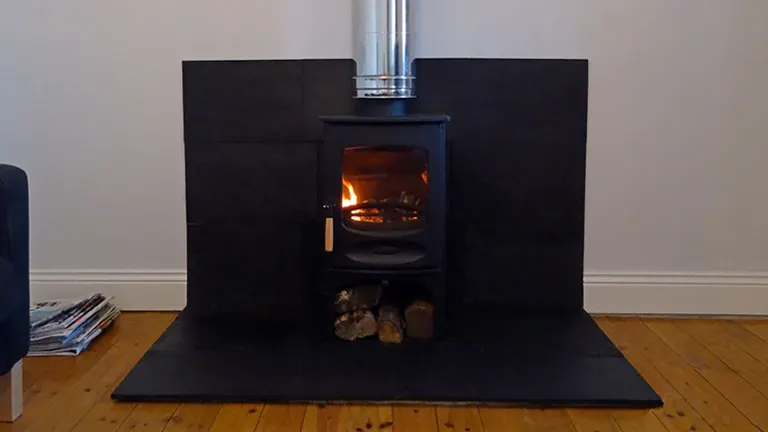
Metal wall shields are an innovative solution to protect walls from heat, particularly in areas where high temperatures are a concern, such as around stoves or fireplaces. They are highly valued for their exceptional heat resistance and robust durability. Homeowners and designers have a variety of metals to choose from, each offering its unique aesthetic and functional benefits. Options include stainless steel, known for its modern look and ease of maintenance; copper, which adds a warm, rustic charm and is renowned for its heat conductivity; and decorative embossed tin, which can provide a more ornate and distinctive style. These shields are designed not just to withstand high temperatures but also to reflect heat away from the wall, thereby minimizing the risk of heat damage. Additionally, their smooth surfaces make them easy to clean, making them practical as well as an attractive addition to any space.
2. Ceramic or Stone Tiles
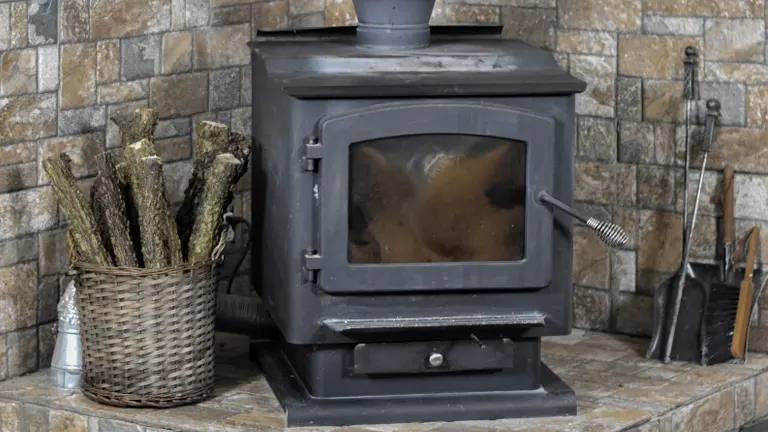
Ceramic or stone tiles offer a blend of functionality and aesthetic appeal, making them an ideal choice for areas that require heat resistance, such as the wall space behind a stove. These materials are renowned for their ability to withstand high temperatures, ensuring that the wall remains protected from heat damage. Beyond their practicality, ceramic and stone tiles are highly sought after for their decorative qualities. They come in an extensive array of colors, designs, and sizes, allowing for a high degree of customization. This versatility makes it easy to select tiles that harmonize with your interior decor, whether you’re aiming for a contemporary, traditional, or eclectic look. Additionally, the use of these tiles is not just limited to functionality; they can be arranged in various patterns and styles, creating a visually striking feature in your kitchen or any other space. This combination of heat resistance and aesthetic flexibility makes ceramic and stone tiles a popular choice for enhancing both the safety and the style of a home.
3. Brick or Stone Veneer

Brick or stone veneer is a superb choice for those seeking to infuse a rustic and traditional ambiance into their space. These materials are not just aesthetically pleasing but also highly functional, particularly in areas exposed to heat, like near stoves. The natural properties of brick and stone make them excellent at absorbing and radiating heat. This capability is crucial in providing an effective barrier that protects walls from the intense heat generated by stoves. The veneer acts as a heat sink, absorbing excess heat and then radiating it slowly, which helps in maintaining a more consistent temperature in the room.
The rustic charm of brick or stone veneer is another significant advantage. It can instantly add character and warmth to any space, making it feel more inviting and homely. The textures and colors inherent in these materials bring a touch of the outdoors inside, creating a cozy and natural atmosphere. Furthermore, the versatility of brick and stone veneers in terms of style and design allows them to blend seamlessly with various interior decor styles, from traditional to modern. This blend of functional heat resistance and timeless aesthetic appeal makes brick or stone veneer an excellent choice for enhancing both the safety and the beauty of a home.
4. Heat-Resistant Plasterboard
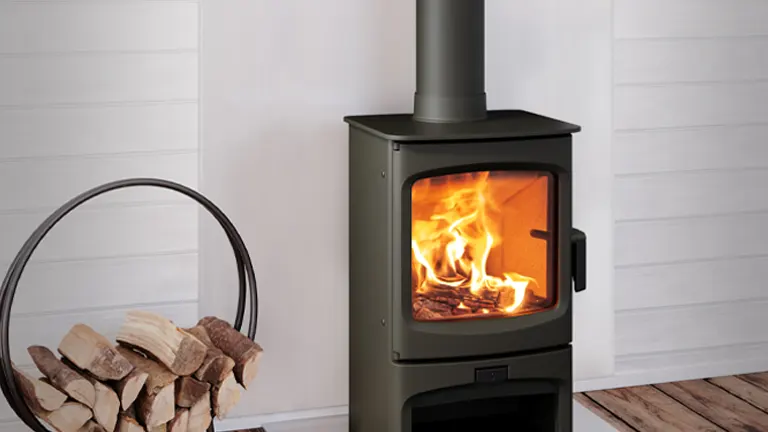
Heat-resistant plasterboard is an innovative building material specifically designed to withstand high temperatures, making it an ideal choice for areas in a home that are exposed to heat, such as kitchens or around fireplaces. This specialized plasterboard is engineered to maintain its integrity and structure even when subjected to significant heat, offering a robust and reliable solution for heat protection.
One of the key advantages of a heat-resistant plasterboard is its versatility in terms of finish and appearance. Unlike some other heat-resistant materials, this plasterboard can be easily painted or finished in various ways to match the existing decor of a room. This flexibility allows homeowners to not only ensure the safety of their walls from heat damage but also to maintain a cohesive and aesthetically pleasing interior design. Whether you prefer a vibrant color, a subtle hue, or a particular texture, heat-resistant plasterboard can be tailored to suit your specific style preferences.
The use of heat-resistant plasterboard is particularly beneficial in ensuring the safety and longevity of walls in high-heat areas. By effectively shielding the walls from heat, it helps prevent damage that can be caused by prolonged exposure to high temperatures. This makes it a practical choice for enhancing the safety of your home while also offering the freedom to customize its appearance according to your personal design tastes.
5. Fireplace Surround Panels
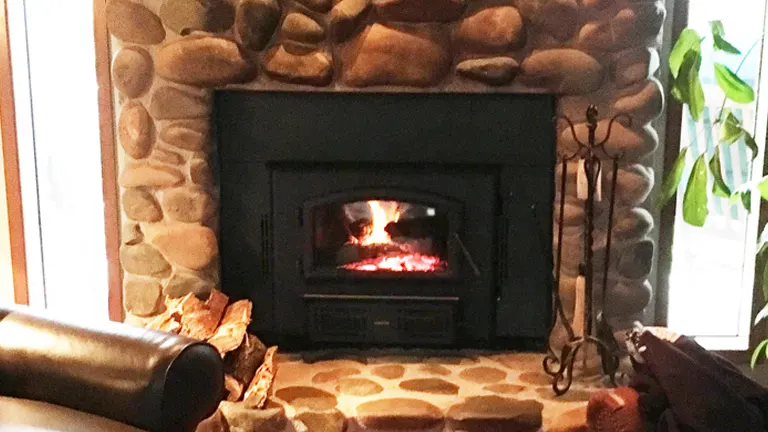
Fireplace surround panels are a practical and stylish addition to any home with a stove or fireplace. These pre-made panels are specifically designed for installation around these heat sources, providing both protection and an aesthetic upgrade to the area.
One of the key benefits of fireplace surround panels is the wide range of materials and designs available. Homeowners can choose from various options to suit their specific style preferences and needs. These materials can include heat-resistant options like metal, stone, or tempered glass, each offering unique qualities in terms of durability, heat resistance, and overall look. The design choices range from modern and sleek to traditional and ornate, allowing for a perfect match with any home decor style.
Another advantage of these panels is their ease of installation. Being pre-made, they are typically designed for straightforward fitting, which can often be a DIY project, saving time and cost on professional installation. This feature makes them a popular choice for quick renovations or updates to the fireplace area.
6. Intumescent Paints
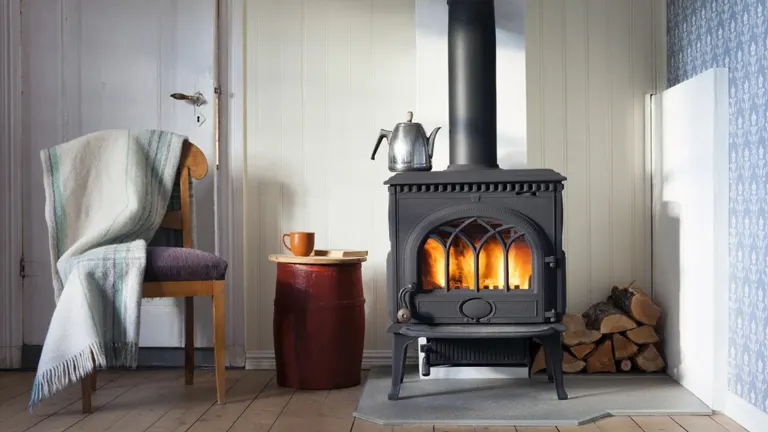
Intumescent paints are a unique and cost-effective solution for protecting surfaces from high heat and potential fire hazards. These special paints are formulated to react when exposed to high temperatures: they swell up significantly, forming an insulating barrier that protects the underlying material.
The key feature of intumescent paint is its ability to expand to many times its original thickness when exposed to heat. This expansion creates a charred layer that is poor in heat conductivity, effectively insulating the material underneath from the intense heat and slowing down the spread of fire. This characteristic makes intumescent paint an ideal choice for enhancing fire safety in both residential and commercial properties.
An added advantage of intumescent paints is their versatility in application. They can be applied to a variety of materials, including wood, steel, and plaster, making them suitable for a wide range of environments. They are particularly useful in areas where other forms of fire protection might be impractical or too costly.
7. Glass Panels
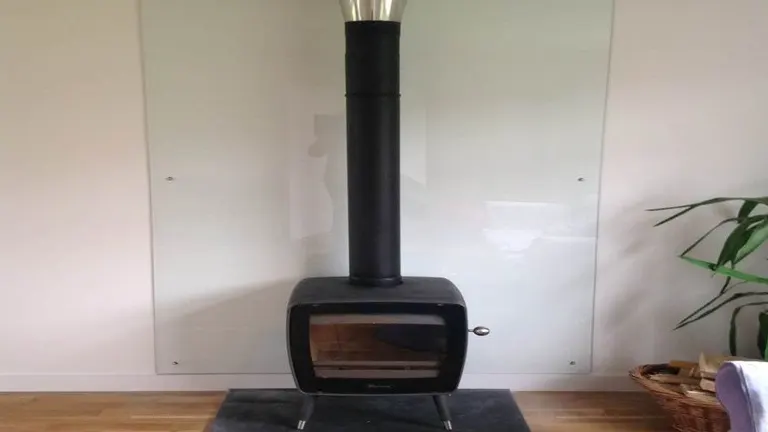
Tempered glass panels are an excellent choice for those seeking a sleek, modern look in their kitchen or any area with a stove. These panels are not only visually appealing but also offer practical benefits, making them a popular choice in contemporary interior design.
The primary advantage of tempered glass is its strength and safety. Tempered glass is much stronger than regular glass and, if broken, shatters into small, less harmful pieces, making it a safer option for use in the home. This strength is particularly important in high-heat areas like behind a stove, where the glass needs to withstand temperature fluctuations.
In terms of aesthetics, tempered glass panels provide a clean, minimalist look. They allow the wall behind the stove to remain visible, which can be particularly effective if the wall has an attractive color, texture, or tiling that you want to showcase. This transparency can also make the space feel larger and more open, a desirable effect in many modern kitchens.
Another significant benefit of tempered glass panels is their ease of maintenance. They are incredibly easy to clean; a simple wipe-down with a damp cloth can remove most splatters and stains. This low-maintenance aspect is especially appealing in a kitchen environment where spills and splashes are common.
The Concept of the Heat Shield
- Basic Understanding: To fully appreciate the role of a heat shield in protecting your home, it’s important to understand its fundamental concept. Materials like brick, tile, or stone, when directly attached to the wall, do not effectively function as a heat barrier. While heating masonry materials is a slow process, once heated, they can rapidly transfer heat to the wall, potentially causing damage or posing a fire hazard.
- Importance of Air Gaps: The key to an effective heat shield is the presence of an air gap between the shield and the wall, complemented by apertures at the top and bottom for airflow. This design allows the heat to dissipate harmlessly into the environment, unlike solid masonry which can conduct heat directly to the wall. This air space is critical in preventing heat transfer and ensuring safety.
- Installation on Combustible Walls: If your home has combustible walls, installing a heat shield can significantly reduce the clearance needed from the stove. Local building regulations will guide the installation process and the required distances. The construction of these barriers typically involves non-flammable materials like sheet metal, and professionals usually mount these shields on spacers about 1 inch (2 cm) away from the wall. This spacing further enhances safety by ensuring proper heat dissipation.
- Stove-Specific Heat Shields: Additionally, some stoves can be equipped with rear heat shields to further limit clearance requirements and protect the walls. However, it’s important to note that this feature is not universally available for all stoves. Each stove may require a specific type of heat shield, tailored to its design and heat output characteristics.
Conclusion
Thank you for delving into the art of choosing the perfect wall protection for your wood-burning stove with us. Safety and style go hand in hand when it comes to enhancing the heart of your home. Whether your aesthetic leans towards the robust industrial grace of metal shields, the warm traditional appeal of brick veneer, or the sleek, contemporary sophistication of glass panels, there is a multitude of options available to cater to your individual preferences.
As you embark on this journey of transformation, we urge you to adhere to the local building codes and follow the stove manufacturer’s recommendations to ensure a seamless and secure installation. Your home is not just a space to live, but a canvas to express your unique style, and a safe haven for you and your loved ones.
We’re grateful for your readership and would love to hear from you. If you have any insights, experiences, or ideas to share, please feel free to leave a comment below. Your contributions not only enrich our community but also inspire others on similar paths. Should you find this guide beneficial, we encourage you to share it and spark a dialogue on safety and design in home heating. Here’s to creating a safe, stylish, and warm abode with your wood-burning stove as the centerpiece!
FAQs
- What are innovative materials I can use for wall protection behind my wood-burning stove?
Beyond the traditional stone or brick, consider using modern materials like tempered glass panels, embossed metal sheets, or fire-rated gypsum wallboard designed with a reflective surface to both protect and enhance the heat distribution in the room. - Can I use reclaimed wood as a protective wall covering if treated with a fire retardant?
While reclaimed wood adds a rustic charm, it’s not advisable to use it directly due to its combustibility. However, if treated with a fire retardant and used as a decorative facade in front of a properly installed non-combustible wall protector, it can add aesthetic value. - How do I integrate wall protection into my living space without it looking out of place?
Wall protection can double as a feature wall. Use materials like slate, decorative ceramic tile, or even sculptural metal pieces that complement your interior design, turning functional safety into art. - Is it possible to use a transparent wall protector so I don’t obscure the existing wall finish?
Yes, transparent heat-resistant materials such as tempered glass are available. They can protect the wall without hiding it, allowing for paint or wallpaper to show through while ensuring safety. - How can I ensure my wall protection is eco-friendly?
Opt for sustainable materials like salvaged non-combustible stone or recycled metal tiles. You can also look for products with low volatile organic compound (VOC) emissions to ensure indoor air quality is maintained. - What are some creative ways to add insulation behind my stove for enhanced heat efficiency?
Consider installing a radiant heat shield made of a reflective metal that not only protects the wall but also directs more heat into the room. Additionally, ceramic spacers can be used to create an air gap behind the shield, improving heat circulation. - Can I customize the look of my protective wall to match the seasons or my changing decor style?
Absolutely. Use magnetic paint or attach a metal sheet to the wall, then apply interchangeable decorative magnetic panels that you can switch out as you please. - Are there any low-cost DIY solutions for wall protection that still meet safety regulations?
Yes, a DIY solution can be both cost-effective and safe. Non-combustible cement board can be installed and finished with heat-resistant paint or stucco for an affordable, compliant wall protector. - How far should my wall protection extend beyond the wood stove?
Regulations often require a minimum of 36 inches of protective material extending from the stove’s sides and rear. However, check with your local building codes for specific requirements. - Can wall protection for my wood stove double as storage?
It’s not recommended to store items too close to the stove due to fire risk. However, you can install floating non-combustible shelves at a safe distance above the stove to combine protection with functionality.

David Murray
Forestry AuthorI'm David Murry, a forestry equipment specialist with a focus on chainsaw operation. With over 13 years of experience, I've honed my skills in operating and maintaining a wide range of machinery, from chainsaws to log splitters. My passion for the outdoors and commitment to sustainable forestry drive my work, which emphasizes safety, efficiency, and staying updated with industry advancements. Additionally, I'm dedicated to sharing my expertise and promoting environmental awareness within the forestry community.









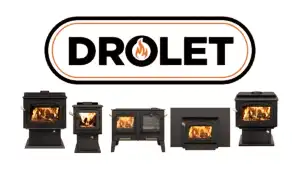
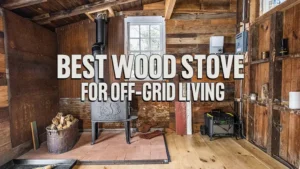

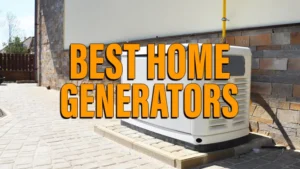
Leave your comment